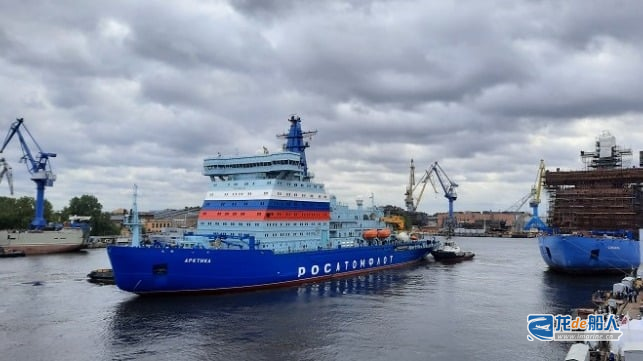Foreign media reported that Russia and India’s cooperation in the field of shipbuilding is further expanding. Russia plans to order a total of four non-nuclear powered icebreakers from two Indian shipyards, which is expected to cost $713 million, and will join the Russian State Atomic Energy Company (Rosatom) icebreaker fleet after delivery for Northern Sea Route (NSR) operations. Rosatom is responsible for the development of the NSR and the management of the icebreaker fleet deployed there.

Indian media reported that the Indian government is negotiating with two shipyards (one state-owned and one private) for the construction of four icebreakers.
As Western countries tighten economic sanctions, Russia’s domestic shipbuilding industry is struggling under the pressure of supply chain disruptions. In July, India Prime Minister Narendra Modi paid a two-day state visit to Moscow and agreed to strengthen cooperation with Russia in areas such as nuclear energy and shipbuilding. At the same time, Rosatom sees India as an important partner in the development of the Northern Sea Route. In particular, India would benefit from efficient imports of Russia’s oil, coal and liquefied natural gas (LNG).
There is information that the order for non-nuclear-powered icebreakers is a follow-up to the agreement between the governments of Russia and India. While the details of the order have not yet been announced, a joint working group of experts from both sides has been put in place to complete the negotiations. The first meeting of the joint working group was said to have been held on 10 October.
India is currently ramping up its support for its shipbuilding industry, which India will benefit from when Russia orders new ship from foreign shipyards. With most shipyards in China, Korea and Japan scheduled to deliver until 2028, and European shipyards unable to take on new orders from Russia due to Western sanctions, Russia is in fact at a critical juncture. In light of this, India seems best placed to help.
Currently, Rosatom personnel have traveled to India to assess the suitability of the shipyard. “The National Science and Technology Research Programme is a common platform for developing multifaceted cooperation in multiple areas, and the company sees great potential for cooperation with India in various fields from developing freight transport to building shipyards,” the company said.
According to the latest data from Russia’s Centre for High North Logistics (CHNL), transit voyages on the Northern Route have reached record levels as trade between China and Russia shifts to the route.
As of September 30, a total of 79 transit voyages were recorded on the Arctic Ocean route, with an estimated cargo throughput of 2.38 million tons during the summer and fall seasons. So far, about 95 percent of goods are shipped from Russia to China. Russia plans to transport about 150 million tons of cargo through the Northern Sea Route by 2030. To achieve this goal, Russia plans to build 50 icebreakers and ice-class ships.
In addition to the icebreaker order under negotiation, Russia also plans to order 24 cargo ships from India’s state-owned Goa Shipyard by 2027. The agreement was signed during the Astrakhan International Forum “North-South ITC: A New Concept” in 2023.
The new ships will be deployed on routes in the Caspian region. The first phase of the order is owned by a Russian-registered subsidiary of Iran’s state-owned shipping company, the Islamic Republic of Iran Shipping Line (IRISL). At present, IRISL is facing serious sanctions from the United States, the European Union and other countries and organizations.
It is understood that the NSR is the “Northeast Passage” connecting Asia and Europe in the Arctic shipping route, which is one-third shorter than the traditional Malacca Strait and Suez Canal route. Due to the melting of Arctic sea ice caused by climate change, the waterway stretches from Murmansk near Russia’s border with Norway to the Bering Strait near Alaska.


